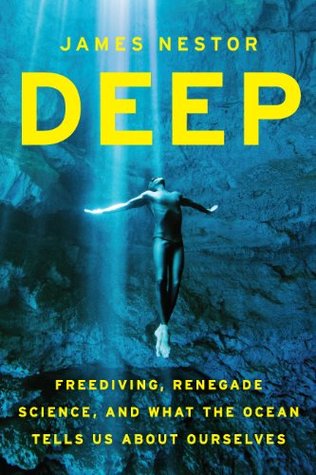More on this book
Community
Kindle Notes & Highlights
by
James Nestor
Read between
September 9 - November 6, 2018
“Scuba diving is like driving a four-by-four through the woods with your windows up, air conditioning on, music blasting,” one freediving researcher told me. “You’re not only removed from the environment, you’re disrupting it. Animals are scared of you. You’re a menace!”
When you’re twenty-seven stories down in cloudy water, all directions look the same. And they all feel the same—the water pressure makes it impossible to gauge whether you’re swimming up, down, or sideways.
SKETCHY MACHINERY, BLACKOUTS, and occasional deaths—all these things make no-limits dives almost unbearable to watch. And it’s not like there’s much to see anyway. As with other freediving disciplines, the action in no-limits dives happens below the surface. You see a diver huffing and puffing before the dive, see him take a final breath, and then, about four agonizing minutes later, you see him resurfacing—blue with asphyxia, often bloody. A trip to the emergency room usually follows. The whole thing looks insane.
Yes, they were swimming where no human had been before. But this struck me as maddening, like an explorer arriving in previously undiscovered wilderness and focusing only on his GPS coordinates.
THE NEXT DAY OUR CLASS meets about a hundred miles inland from Tampa in a dirt parking lot outside the town of Ocala. Across the lot, in the shade of candleberry trees, is a dent in the ground that looks as if it’s been punched by a giant, angry fist. At the bottom of the hole is a pool of bright green water known as the 40 Fathom Grotto. As the name suggests, it plummets down more than 240 feet.
The blue ocean water (and sky) we see from the surface has nothing to do with the color of water or air—both, of course, are colorless. Tropical water appears intensely bluish-purple because the visibility extends for hundreds of feet, allowing you to peer into the depths where only blue and purple light can penetrate.
Blue fish are exceedingly rare in the ocean, because they would be highly visible until they reached the lightless waters of the bathypelagic. Meanwhile, red fish are fairly common because red is the best camouflage in deep water. A fish like a red snapper looks red at the surface, but as it descends, the redness appears to fade away until, at around a hundred feet, it becomes virtually invisible to its prey and predators. This is why snapper spend almost all their time at between fifty and two hundred feet.
In the distance, a group of glittering disco balls hangs a few feet above the seafloor. It’s a school of squids, Stanley tells us. Each is wrapped in a Technicolor coat more sparkly and garish than the next. Beside the squids are other animals—jellyfish, I think—that emit bright pink and purple light. It’s like we’ve stumbled into some underwater Studio 54.
I feel an emptiness in my chest that breath can’t fill. This is the real Earth, the 71 percent silent majority. And this is how it looks—gelatinous, cross-eyed, clumsy, glowing, flickering, cloaked in perpetual darkness and compressed by more than a thousand pounds per square inch. The azure sphere we see from the space is only a veneer. Our planet isn’t really blue, it’s not filled with leaves of grass, clouds, color, and light. It’s black.
Freedivers condition their bodies to tolerate high levels of CO2 using timed breath-hold exercises called static tables. Essentially, it’s interval training. Breathe two minutes, take four huge breaths, hold breath for two minutes; breathe one and a half minutes, take four huge breaths, hold for two and a half minutes, and so on. The aim of static tables is to increase breath-holding time while decreasing the rest interval. Within a few weeks, I hit my goal of three-minute breath-holds with only one-minute rests in between.
In fact, 236 decibels is so loud that a sound of that intensity cannot exist in air. Above 194 decibels, sound waves turn into pressure waves. Although decibels are used to measure sound intensity in both air and water, the intensity of sound in both of these mediums differs. In other words, a decibel is a relative unit of measure. (For instance, an 80-decibel sound will be quieter in water than it is in air.) But this distinction doesn’t make sperm whale clicks any less impressive, or lethal. Even underwater, sperm whale clicks are so loud they could not only blow out human eardrums from
...more
Meanwhile, last year Schnöller had a face-to-face encounter with five sperm whales that lasted three hours. The entire dive was documented
But not these animals. Corliss and his crew had stumbled upon not only a new species, but an entirely new biological system fueled by chemicals. Scientists called it chemosynthetic life. The Garden of Eden would be recognized as one of the most significant scientific discoveries in human history.
These Challenger Deep analogies keep looping in my head—The Stratosphere of the Sea; The Mount Everest of Inner Space—until a minute becomes an hour, daylight turns to night. Barclay and I sigh and stare and wait.


